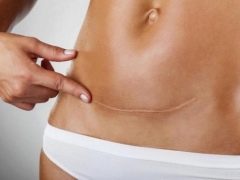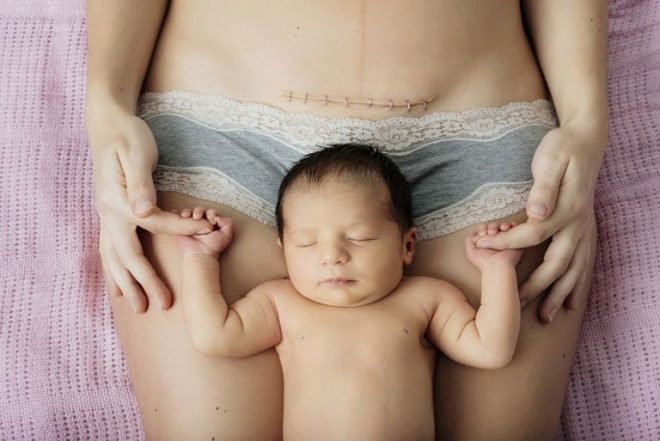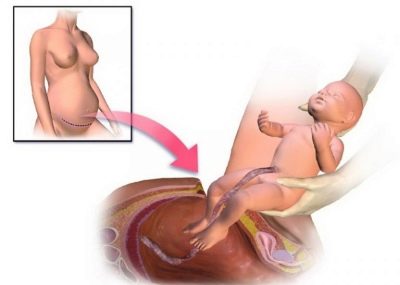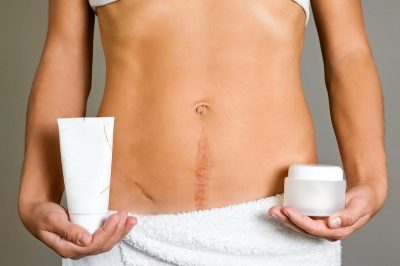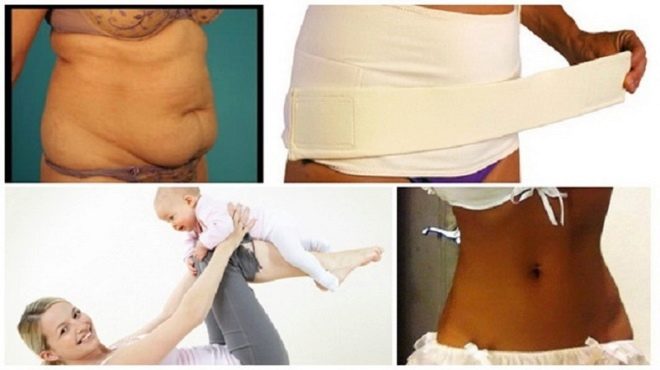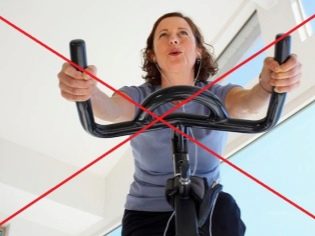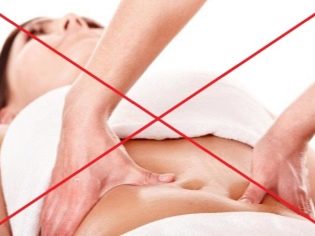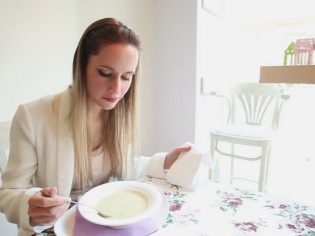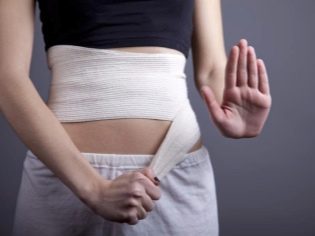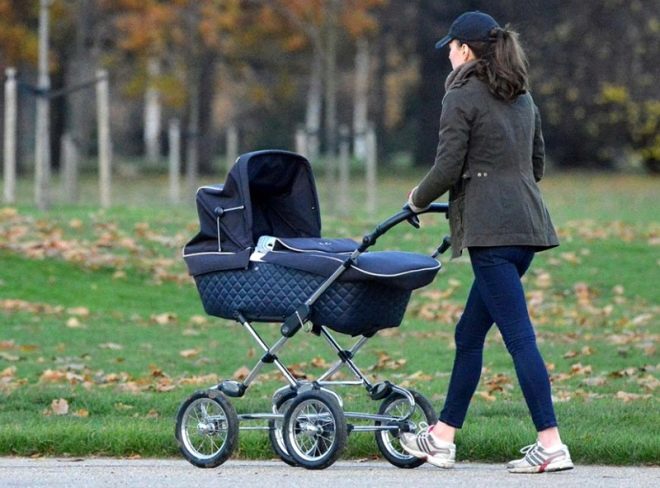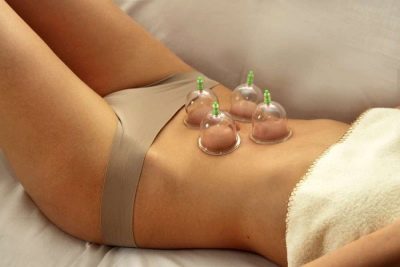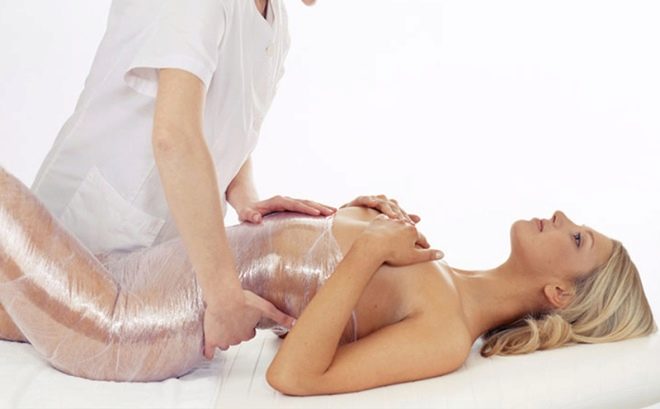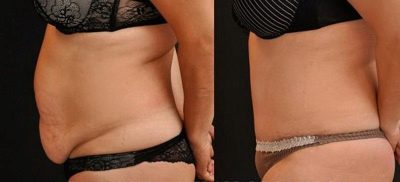Put in the shape of the belly after cesarean section
Caesarean section left behind. The newly-minted mother enjoys communication with the baby, but from time to time she thinks about why the belly was big and whether something can be done with it. After childbirth physiological woman in a short time can begin training, play sports. After cesarean section, there are a number of severe restrictions that prevent a woman to quickly get rid of the hated skin fold over the suture and sagging of the abdomen. In this article we will look at what methods are acceptable after surgery and how to get yourself in shape.
Why does the stomach sag?
A caesarean section is a serious abdominal surgery. When dissecting the abdominal wall, the integrity of the nerve endings, blood vessels, muscle tissue is disturbed. After extracting the fetus and placenta, doctors put internal and external sutures. But it will take time to restore the integrity of each of the cut layers.
That is why a woman feels numb in the lower abdomen and in the pubic area for quite a long time after the operation, which is why it is so difficult to understand how to put the previously cut muscles in order, because their contractile ability is disturbed.
The abdomen sagged after the operation, not only due to the fact that additional kilograms were gained during the baby's bearing, although for this reason too. The skin on the abdomen is over-stretched, it takes time for the extra cells that appeared when stretched to "self-destruct". Stretched skin is badly lacking its own collagen. Among other things, a woman during pregnancy was used to moving with a center of gravity shifted forward.
You should not think that a sagging tummy is forever. If you do not run the situation and take it under your control, it disappears. There is only a scar in the place of imposition of external seams and a scar on the uterus, which is visually indistinguishable.
Recovery features
Recovery after cesarean section is longer than after physiological labor. The sufficient amount of collagen needed to improve the skin tone on the abdomen will appear over time when the incisions on the skin grow together. First, connective tissue should form and the vessels should recover. Muscle tissue, which was also dissected and stitched with a solid single-row or double-seam, should be combined with the formation of new characteristic muscle cells. At last, nervous sensitivity returns.
Primary accretion with primary scar formation occurs during the first week after surgery. After a month, there is still little collagen in the skin, and the scar is hard and looks rather unsightly. After 3-4 months, it begins to soften, as collagen appears and the area of suturing becomes more elastic.
Postnatal rehabilitation, if the childbirth itself was performed surgically, should be given special attention, since the health of the woman, including reproductive health, depends on how well the woman follows the recommendations.
Considering that the recovery period that takes place inside the tissues, and therefore is not realized by the puerperal, is rather long, you need to understand that quickly remove the stomach will not work. Especially when it comes to recovery after the second or third cesarean section. Even if a woman had a perfect flat stomach before pregnancy, carrying a baby and surgical childbirth necessarily affect its condition.
Internal scars begin to form within a day after surgery. A week later, they are already quite elastic, but still very thin. That is why a woman should monitor her activity and physical activity in order to prevent late complications of postoperative scars. Complete healing of internal sutures takes about 8 weeks. Outer sutures heal by 10 days, and after they are removed, healing continues for about two weeks.
Thus, it is reasonable to begin to practice your belly no sooner than the recovery time is completed, that is, two months after the birth of the child.
Can it get sucked in by itself?
If a woman before pregnancy was the owner of a slim figure and a flat tummy, then an independent restoration of the abdominal wall is quite possible. After what time the stomach will become beautiful again, it's hard to say, much will depend on the lifestyle of the newly-made mother, her activity, her constitution and weight. But usually in such women the abdomen falls within six months or a year after giving birth.
But leave it to chance this question is not worth it, even if there is hope for an independent recovery. First of all, it is a postoperative scar. Bringing the stomach into shape includes this item - purely aesthetic. Most of the means for local use, which saturate the skin with collagen from the outside ("Contractubex", For example), can have an effect only at an early beginning of treatment. If a scar is a year or more, local funds will no longer be effective against it.
Restoring the tone of the muscles and skin of the abdominal wall will require an integrated approach, which will include permitted physical activity, proper nutrition, strengthening the muscles of the abdominal wall and the use of topical agents.
A woman of any body size, if she sets herself the goal, will be able to get her belly in order after a cesarean section, but before embarking on this labor-intensive process, one should have a good understanding of the list of actions that are prohibited and also know about all the limitations of the postoperative period.
Restrictions and general rules
Limitations invented by doctors not from scratch. A woman after cesarean section and after a few days, and after a few months, various complications can arise from the scarring. It may be a hernia, ligature fistula, adhesions. The prospect of enduring and giving birth to another child may be at risk, because of the traumatic factors and complications, an insolvent uterus scar can form. Therefore, a woman after a cesarean section delivery operation is strictly prohibited:
- To visit the gym, work out at the gym, do exercises with dumbbells, a barbell, pedal the exercise bike, rock a press. The ban on severity is valid from the first days after surgery and up to a year. And the press can be pumped only after the first eight months, and then with great caution, increasing the load very smoothly and gradually.
- Carry a weight of more than 3-4 kilograms. In the first weeks after the operation, it is better to limit weight to 2.5-3 kilograms, if the child is large, you must ask for help in caring for them from relatives or friends. Six months after the operation, the maximum weight allowed for lifting can be increased to 6 kilograms. It is possible to return to usual loadings only in a year.
- Make sharp movements. Squats, bending forward from a standing position, a sharp rise from the bed - all these are loads that are not shown after a cesarean section and which can lead to the development of complications.
- Go to the bath, steam, go to the sauna, swimming pool. The ban is valid from the moment of the operation for three months. After three months, a woman can afford such leisure (including for weight loss), but only after the obstetrician-gynecologist at the place of residence states the absence of postoperative complications.
- Massage the abdominal muscles by any means until the moment 5-6 months after surgery. Remember that muscle tissue is recovering for a long time. This ban applies to all types of massage, including vacuum banks. The only exception is the stroking manual technique, which does not imply deep kneading of muscle and adipose tissue.
- Limit yourself to food. Rigid mono-diets, starvation is not shown to nursing mothers, and the state of the abdomen is not strongly reflected. On the contrary, sudden weight loss as a result of mono-diets can lead to additional sagging of the skin and muscle weakness. Removing the belly will become more difficult.
- Drink hormones to reduce appetite, antidepressants and other drugs for weight loss., including herbal tea laxative, if a woman feeds your baby with breast milk.
- Flatten the stomach. If the injured tissues are slackened, the blood supply is disrupted and their normal recovery slows down. Only wearing postpartum brace is acceptable.
Looking at this list, a woman can conclude that all effective ways to eliminate a sagging tummy are prohibited. This is not true. There are quite safe and effective ways to restore the tone of the abdomen after cesarean section, and we will talk about them in more detail.
Nutrition
Fasting days, fasting and mono-diets are not suitable for nursing mothers or for non-nursing women after surgery. The woman's body needs strength, energy, vitamins and minerals, not only to produce breast milk and ensure the needs of the baby, but also to restore its own immunity, because any surgical operation greatly weakens the immune defense.
Therefore, you need to form power on the principle of diversity, balance. By and large, it is not necessary to deny yourself anything, you just need to understand what, when and how much you can eat.
The basic rule of nutrition, without which the effect will be extremely difficult to achieve, is fragmentation. It is necessary to eat a new mother at least 6 times a day. But each serving should be dosed. The total weight eaten per meal should not exceed 350-400 grams.
It should also be mandatory to drink plenty of water. At least 2 liters of water a day is a guarantee of good health and a rather intensive weight loss. Drink only need clean water without gas. No soda, kvass, sweet compote. Only clean water at room temperature. Fluid hotter or colder is worse absorbed by the body. In addition, drinking at room temperature has a beneficial effect on lactation.
The third fundamental rule of nutrition for improving the tone of the abdominal muscles is the balance of nutrients. Make sure that about 40% of the daily diet is protein. For carbohydrates, take no more than 25%, and for fats - 35%. Each meal should contain all three groups of substances. This is a prerequisite for their better absorption and acceleration of metabolism.
Plan your menu for the week ahead. This disciplines and allows not to deviate from the specified quantitative values.
What products will have to be completely abandoned? It's all pretty predictable. These same products were not recommended during pregnancy, so for those who tried to eat properly while waiting for the baby, there will be no new discoveries. Should be avoided:
- pickled products (vegetables, fish, meat);
- canned food (any);
- over salted foods;
- flour products, sweets, cakes and chocolate, jam and sugar;
- smoked and cooked sausages, sausages, smoked bacon, meat, fish;
- fried foods and dishes;
- fatty meats, fish (lamb, fatty pork, lard, mackerel, herring);
- of alcohol.
What you need to have:
- vegetables;
- fruits;
- boiled, stewed, baked vegetable dishes;
- steam and boiled meat, fish, poultry;
- cereals (except manna);
- milk and dairy products.
Carefully add a small amount of vegetable oil, try to avoid the abundance of spices, so as not to spoil the taste of breast milk and stir up your own appetite.
As you can see, you will not have to limit yourself much. Moreover, it is possible to create a very rich and tasty menu from the products we have listed. The main thing is not to forget about the three main rules described above - the weight of food at a time - no more than 400 g, plenty of drinks and the balance of substances. Here is an example of the right lunch:
- cucumber salad and tomato, seasoned with vegetable oil (100 g);
- ear with sour cream (150 g);
- Boiled buckwheat-buckwheat (50 g);
- fish stew mintai (fillet) (100 g).
Total weight - 400 grams.
So you need to make all five meals, and the last one, which falls three hours before bedtime, should be made light by eating only an apple or drinking a glass of ryazhenka.
Here are some more important rules for proper nutrition after cesarean section:
- avoid foods that cause bloating (cabbage, beans, white bread, yeast), this is especially important in the first months after surgery;
- never, under any circumstances, skip breakfast - this is the most important meal of the day;
- never go hungry, but if you wanted to eat out of schedule (although it is hard to imagine, you have to eat every 2.5-3 hours), eat, but choose something light that is digested in a short period of time, for example, low-fat cottage cheese or green apple.
Gymnastics
Start doing gymnastics after at least one and a half months after the operation. To get started, use only gentle exercises from the arsenal of physical therapy. This is all well known walking on the spot, the torso, the circular rotation of the hips.
To remove the stomach, physical therapy, of course, will not help, but it will create an excellent ground for future training, since after the operation all muscle groups are somewhat hypotonic.
To light morning exercises, add a walk. On the street with the baby, you can go after the newly made mother removed the outer seams. Walking on foot perfectly helps all muscle groups, including allowing you to tighten the muscles of the abdominal wall. You need to be well aware that standing with a stroller at the entrance or sluggish retreading on the playground to walking useful and creating your body has nothing to do.
You need to walk in a measured, leisurely, but quite energetic way. For such a walk with a stroller, an alley of a park or a public garden, a forest-park area is perfect, as long as it is located far away from the roadway.
When from the time of cesarean section has passed about 5 months, you can begin to do more complex exercises for the abdominal muscles. When lying on your back on a solid surface (for example, on the floor), slightly raise the right and left legs in turn, first low - by 25-30 degrees. You can use a roller under the legs.
Gradually, the legs can be raised higher, the roller is removed, and then we proceed to the full swing of the press with the rise of the body. It is not possible to pump up the abdominal muscles quickly, and there is no need to strive for this. Any load should be gradual and reasonable. The “plank” exercise loved by women after cesarean section helps to strengthen the abdominal muscles, but the transition to this exercise can only be done after preliminary training, which we have already described.
Swimming and water aerobics
Swimming and gymnastics in the water is an excellent solution for strengthening the abdominal muscles. You can do this within three months after cesarean section, if there are no contraindications from doctors and postoperative complications.
There are groups for beginners in any pool, classes are not expensive, and therefore a young mother can only find helpers who will agree 2-3 times a week to stay with the baby for 2-3 hours while the mother herself is in the pool.
In water, a woman can even perform exercises on the abdominal muscles, since these muscles will not experience stress in the aquatic environment. Gymnastics in the pool - a great option to strengthen all the muscles, while not exposing yourself to undue risk of excessive physical exertion.
Some new mothers are embarrassed to go to the pool "with such a belly." Experiencing not worth it. In the group, besides you, there will be others “with the same stomach, and even worse,” besides, the coach always creates the most favorable psychological conditions for those involved in order to avoid focusing on someone’s physical disabilities.
If you can not swim, this is also not a reason to deny yourself the pleasure. In groups of aqua aerobics apply special holding belts for those who do not know how to keep afloat. Therefore, training will be completely safe.
Massage
The massage should be started only after the sensitivity of the abdomen returns (approximately 8-10 months after the operation). You can visit a professional massage therapist, you can do massage yourself at home. To do this, you will need massage oil or cream, as well as knowledge of the main areas of impact for tightening the muscles and skin of the anterior abdominal wall.
Apply warm cream or butter, lightly rub it on the stomach. Rub the abdominal wall in circular motions. Two palms draw a line from the center of the abdomen to the sides. Grab the fat folds, if any, with your fingers, remember them easily, gradually increasing the pressure force with your fingers, then relieve the pressure and gently stroke the belly again.
Massage can be done 1-2 times a day. Later you can add vacuum massage to the massage procedure. They are easily installed on the skin of the abdomen. With her right and left hand, a woman gently leads them across the skin. Banks sit pretty tight, because under them a vacuum is formed.
After such a massage fat burning effect is evident. But at first, a woman will have to face such an unpleasant side effect of vacuum massage, like bruises on her stomach. They can be of different intensity and location. Usually hematomas are formed in places where the banks initially impose.
Do not apply banks directly on the postoperative scar area.
Other methods
If the stomach does not go away, mesotherapy may come to help the woman. This method refers to the methods of alternative medicine and involves injections under the skin or intramuscularly certain drugs. This technique is not shown to everyone, and the effect of it, despite the rather high cost of procedures, does not always meet the expectations of the woman. Before mesotherapy, you can visit several sessions of peeling, then the effect will be more pronounced.
After 4-5 months from the moment of surgery, a woman can try to twist the hoop. Classes with an acupuncture hoop, the so-called “with cones” hoop, have a particularly pronounced effect. At first it may seem painful and the hoop may even leave bruises on the belly and sides of the newly made mother. But gradually the discomfort during the session will decrease, and the result will become more visual.
It is possible to tidy up the stomach with the help of wraps, especially in the opinion of women, wraps with honey and kelp. Modern cosmetology is ready to offer other methods, such as hardware laser cavitation on the abdomen and thighs, laser lipolysis.All these methods are recommended to be applied after the sensitivity of the abdominal wall is restored, that is, approximately 7-9 months after the operation.
They will help to tidy up the stomach especially effectively if you combine procedures with proper nutrition, gymnastics and other recommendations.
"Apron on the stomach" - how to get rid of?
In some cases, women form a large skin fold, which hangs over the suture. Plastic surgeons call it an "apron" for its characteristic location. At home, from the "apron" is almost impossible to get rid of. But special operations, such as abdominoplasty or pannicutectomy, help restore the aesthetic appearance of the abdomen.
Abdominoplasty is a rather long surgical operation in which doctors will restore the layers of the fat, muscle and skin layers of the abdomen. Despite the complexity of the intervention and the long operating period, this is one of the most effective plastic surgeries, the guarantee of a smooth tummy after it is almost lifelong, unless, of course, a woman starts to eat candy in kilograms or gets pregnant again. But as minuses we can mention a rather large list of possible negative consequences, from infection to necrosis of tissue sections after surgery.
Paniculectomy - a more benign effect. Surgeons with a scalpel remove only excess fat and only excess stretched skin. Muscles do not touch, they have no effect. Therefore, the operation may have no effect if the reason for the sagging of the abdomen is in the divergence of the muscles after cesarean section.
Anyway, The decision about the tummy tuck is very responsible, it must be made not only by a woman, but also by a group of doctors. If there are other ways to eliminate the "apron", they definitely need to use. But even before the operation, if a woman is determined to do it, you need to lose weight and put yourself in as much order as possible. This will make it easier for plastic surgeons to do this.
Reviews
For the most part, women who complain that they didn’t differ by thinness and had a certain amount of fat on their stomach complain of problems with a slack belly after giving birth. Everything is complicated if, moreover, a woman gains about 20 kilograms for pregnancy. She gets in shape much slower and more painful (as was warned during pregnancy, but in vain!).
Most women in their reviews on thematic forums on the Internet note that by the age of three years, the stomach has finally returned to its former state and without gymnastics with a diet. But not all young mothers agree to wait for three years.
Six months after Cesarean section, young mothers who do not have much free time to visit the gym or pool recommends outdoor games with the child, in which the weight of the baby will be the physical exercise for the mother - put the child on their feet and swing up and down while sitting in a chair on the couch.
Breastfeeding in itself contributes to weight loss, moms say, but the doctors disagree with it. The metabolism in the body of a nursing woman is different, and fat burning in it is somewhat slowed down (the body is in a saving mode to provide the necessary child). After the end of breastfeeding, according to reviews, the stomach usually decreases at a faster rate.
Experienced mothers do not advise rushing to diets and gymnastics, because early attempts are not only dangerous to health, but usually do not have any pronounced results. - neither the weight does not go away, nor the stomach is drawn in. But after 5-6 months from the moment of operation, the pace of losing weight and bringing the abdomen back into shape is much faster. If efforts and efforts are there, but the result is not visible, the young mother can become depressed, which she doesn’t need now, because breast milk can disappear. You just need to be patient.
How to remove the abdomen after cesarean section, see the following video.
